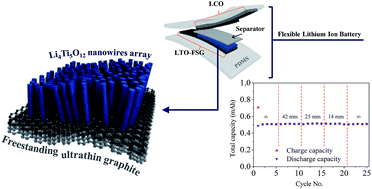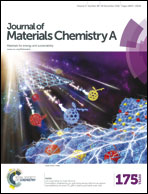Additive-free synthesis of Li4Ti5O12 nanowire arrays on freestanding ultrathin graphite as a hybrid anode for flexible lithium ion batteries†
Abstract
Interest in high-power, lightweight, and flexible lithium-ion batteries (FLIBs) to fulfill the energy requirements of future flexible electronic devices is increasing. To fabricate a thin FLIB, which consists of flexible components, we herein describe, as a model study, a hybrid electrode structure that includes no binders, conductive agents or metal current collectors. A freestanding ultrathin graphite (FSG) film was used as both the current collector and the anode, over which vertically aligned Li4Ti5O12 (LTO) nanowire (NW) arrays were grown. For comparison, two different additive-free electrodes consisting of an LTO NW array on titanium (LTO–Ti) and an LTO NW array on FSG (LTO–FSG) were prepared; they exhibited discharge capacities of 158 and 154 mA h g−1, respectively. The capacities remained approximately stable even after 500 cycles at a 20C charge/discharge rate, revealing outstanding cycling stability of the electrodes. The high-rate performance of the additive-free LTO–FSG electrode revealed excellent rate capability. Finally, the flexible LTO–FSG electrode was used to assemble an FLIB. This novel approach of preparing an additive-free and flexible hybrid electrode enabled the fabrication of a high-power, thin, and lightweight FLIB that exhibited no physical deterioration or performance loss.


 Please wait while we load your content...
Please wait while we load your content...